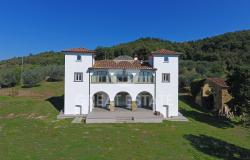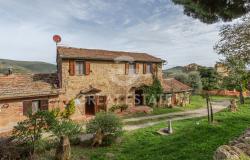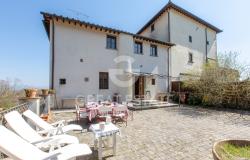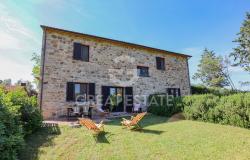The magic begins from the moment the electric gates gently open and usher you into the beautiful estate of the Villa Medicea, in the completely unspoiled region of Arena Metato in Tuscany, just a five-minute drive from the beautiful city of Pisa. A short walk through the manicured parkland surrounding the imposing villa, with an abundance of magnolia and oak, pine and fruit trees, reveals the building’s impressive facade built in perfect Florentine style. A massive 40 metres wide and 20 metres deep, the facade has spacious windows framed with pietra serena (river stone). The centrepiece, at the entrance, is a beautiful coat of arms of the Medici family carved from Carrara marble. The 16th- century house itself is a rare example of only a handful of such villas in the province of Pisa to have been built and inhabited by the famous Medici family, rulers of Florence until around 1700.
Since 1974 the Villa Medicea has been the magnificent home of university professor Riccardo Cerretti and his wife Silvana Piacentino, a marketing executive. They have meticulously restored it to its antique splendour while bringing up their four children there.
A Suitable Mansion Both the Medici family and the property share a rich, dramatic history. Guilio de Medici (1532-1600), who originally commissioned the building of the villa, was the son of Alessandro de Medici, Duke of Florence and the great grand-nephew of Lorenzo il Magnifico. Guilio was five years old when his father was assassinated and had to disappear for some years under the protection of his uncle Cardinal Innocenzo Cybo to avoid the same happening to him. Once grown up, Giulio was appointed First Admiral of the Medicean Fleet by Cosimo I, then the Duke of Florence, and sent to Pisa. Looking for a suitable mansion he found, among the estate properties of his family, a vast area of fertile land near Pisa, in an ancient village called Arena, just alongside the river Serchio. It was there that Giulio decided to build the villa. Riccardo and Silvana bought the house from Antonio Federighi, whose family had owned it since 1854. The two huge floors contain a total of 19 main rooms including seven magnificent bedrooms in addition to various bathrooms and utility rooms.
‘We found the villa in disastrous condition,’ says Riccardo. ‘Part of the roof was ruined, a lot of floors were missing, and the garden was wild after more than 15 years of neglect. The previous owners had used much of the house as a store.’ Despite this, Riccardo and Silvana decided the house would be a suitable project for them.
‘We bought the villa at first sight, it was real love,’ he adds. ‘We asked the Ministry of Monuments to help us with the purchase and the paperwork in accordance with Italian law.’
They started researching the history of the villa which they were sure was a building of historical importance. ‘The Superintendency of Monuments, the Pisan branch of the Ministry, realised that we were not simply building speculators and helped us find funds for the restoration. In those days some money was available for such operations. They also helped us find appropriate craftsmen for the restoration work. In Italy, with so many monuments, it is not so difficult to find them!’
As an engineer, Riccardo felt immediately that the villa looked much worse than it actually was, and so with great enthusiasm began the restoration of the house, which took around eight months.
Epic Restoration
The couple installed beautiful pavements of cotto fiorentino around the property, added ceilings with frescoes and oak beams and new luxurious bathrooms, plumbing and electrical systems. The windows feature typical Florentine stone pilasters and boast magnificent views of the Apuan Alps.
‘Every part of the villa is beautiful,’ says Riccardo. ‘My office is adorned with frescoes, probably from the mid-1800s, with views of the outskirts of Pisa.’
The architect of the villa is unknown, but its style and coat of arms suggests the celebrated architect Bernardo Buontalenti (1536-1608) of Florence, official architect of the Medici family and active in the Pisa and Leghorn region during that period, the second half of the sixteenth century.
Riccardo and Silvana have transformed the building, introducing every modern convenience without destroying its considerable period charm. Due to the villa’s great size, a total of four heating systems were installed in around 1990, substituting the earlier centralised heating system.
‘There are two per floor, and each operates independently,’ says Riccardo. ‘The house has one office area and one apartment on the ground floor, and a big flat on the first floor, divided into a night area and a day area. We thought that four heating systems would be the most economical way of doing things. You can switch them on and off when needed.’
This is just as well, because everything is on an epic scale: there is a spectacular drawing room with vaulted ceilings and two terraces, and a huge entrance hall with a 15th-century fireplace again adorned with a Medicean coat of arms. A tower adorns each side of the building. ‘We don’t know the early significance of the towers,’ says Riccardo. ‘They currently house a collection of birds, including a magnificent barn owl which has become part of our family.’
Originally the villa had its own chapel, which has since been moved to the centre of Metato village, a mile away, where it can still be seen.
Difficult Decision
‘We’ve put our hearts and souls into the restoration,’ says Riccardo. ‘We designed all the interiors and decided on the best way to use each room, whether music rooms, offices and libraries, disco and bedrooms, or kitchens and bathrooms. My wife played a decisive role in the interior decoration and sourced furniture that was completely non-existent - so we personally found every piece. We have learnt that to buy and restore such an exceptional building needs real love and commitment,’ he continues. ‘It’s quite an undertaking to live in a Palazzo da Signori (Stately Home) as the villa was once described in a formal document!’
‘The project was ambitious, but only from an intellectual and artistic point of view. One must study the history, the times, the places. Believe me, it is worthwhile.’
After 28 years, Riccardo and Silvana have reluctantly put Villa Medicea up for sale. ‘It hasn’t been an easy decision,’ says Riccardo. ‘But now the two of us are alone in such a big building we’d like a smaller living space. We’re very fond of the villa and we love living here, but we think that the investment is a bit too great for a simple family home. Our hearts kept telling us not to sell - it was a constant struggle between heart and head to do so.’
The Villa Medicea was available through Sotheby’s International Realty at 5 million Euros (sale price of 2002).










